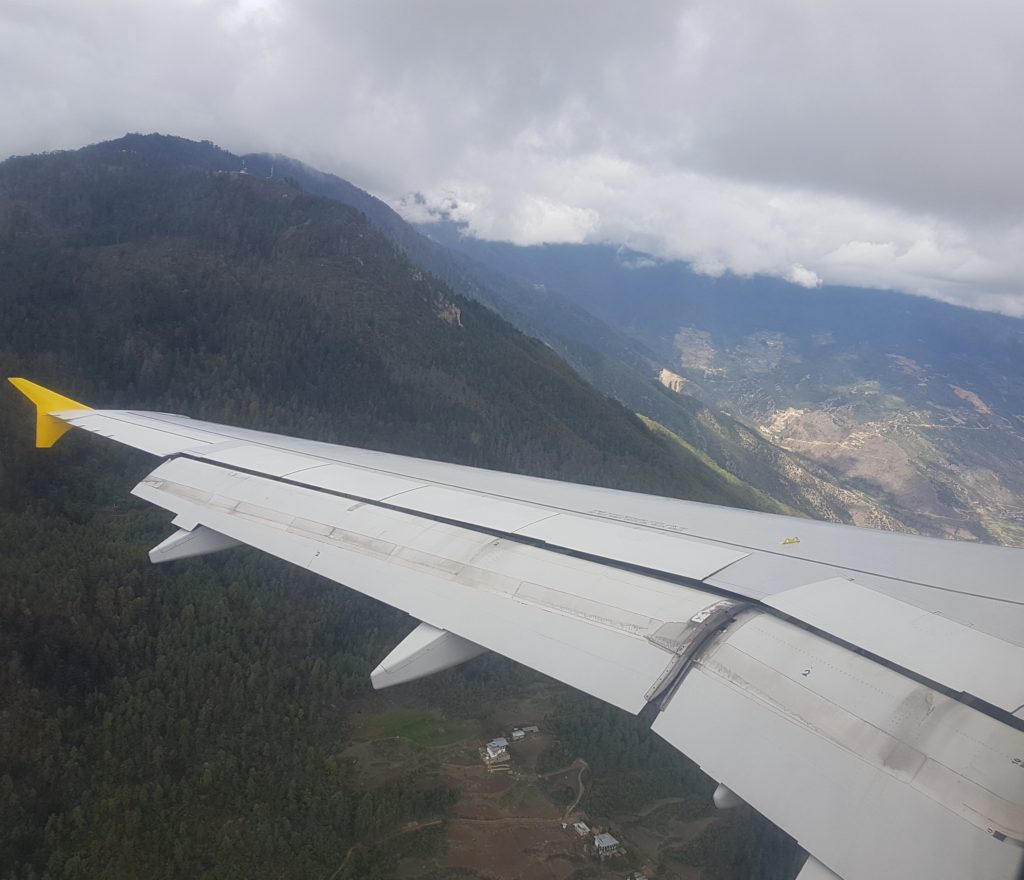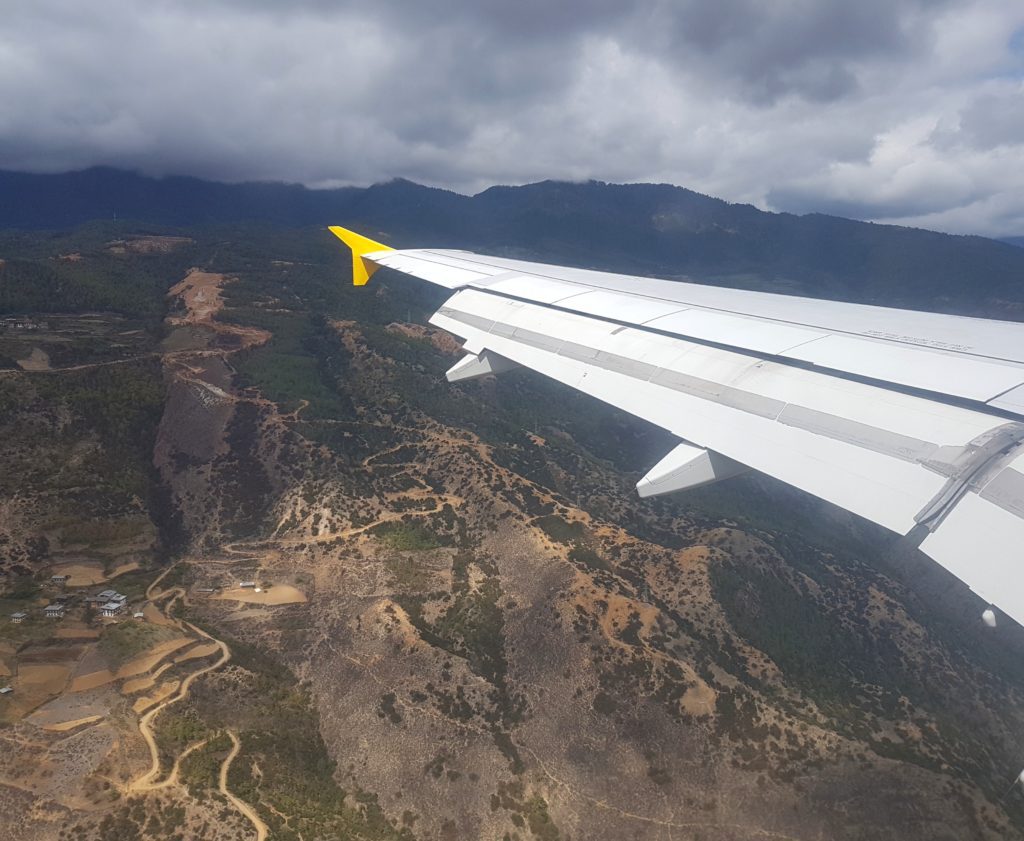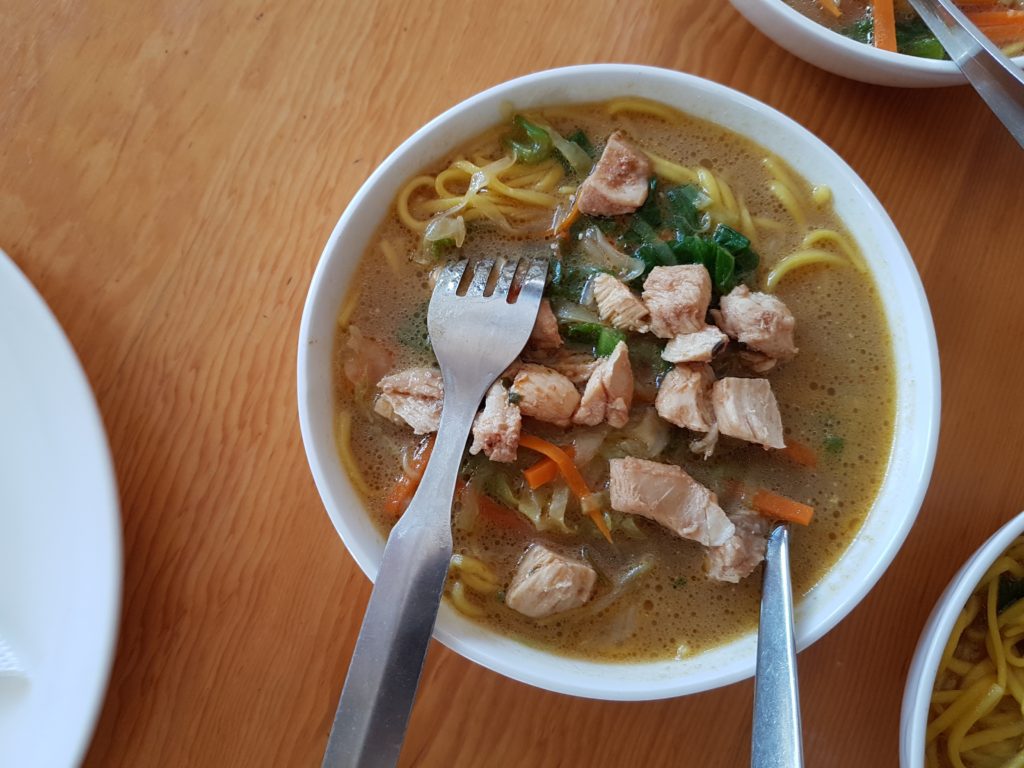Last Updated on April 11, 2021
Unspoilt. Stunning. Innocent. Happy. Contented. Grounded. Shangri La. Last Himalayan Buddhist kingdom….and many things more.
That’s what you get to hear about Bhutan from those who have been there or even heard or read about a country there is every reason to travel to.
When we visited Bhutan, it was a big moment as we were about to strike off one of the top places in our bucket list. We knew what to expect. But, Bhutan knew better than that. What we saw and experienced was many times over all the deserved hype.

If you have Bhutan in your list too, you may be familiar with many of the points here. But do read up to get our perspective that stems from the awesome time we had there on our 10-day trip.
If you haven’t actively considered Bhutan, here are 15 reasons why you must seriously look at the Land of the Thunderbolt as your next travel destination.
Land of Happiness
Yes! First things first. Ever heard of happiness being so important for a country that they replaced their Gross Domestic Product with Gross Domestic Happiness?

We are not even talking of the Scandinavian nations that are, reportedly, the happiest in the world. Right here in Asia, there is tiny Bhutan that believes all that matters is being happy.

And that brings us to the next reason you must travel to Bhutan to see this delightful theory in action.
A stunning entry into Bhutan
If you were to fly into Bhutan which is the more popular and the comfortable way to enter the country (instead of driving in from the Indian side which is an experience in itself), the approach and landing at Paro International Airport can be a real adventure, to begin with.
Everything about the flight into the picturesque Paro airport is different from your usual international entry by air.
But the adventure really begins once you enter the Bhutanese airspace. As for the approach itself, you know you are in Bhutan as the mountains start appearing outside your plane’s window. And just when the descent begins into Paro, you notice high snow peaks towering over 18000 ft (5500 m) on the horizon.
As you peer out of the window, you notice your craft navigate its way at a 45-degree angle between a long and narrow valley buffeted by tall cliffs on both sides.
You know it’s one of the most dangerous airport landings in the world, but there are some technicals here. Paro happens to be an airport without radars or an ILS. And the runway strip is just half the length of most of the international airports – 7,431 ft long – and only visible moments before landing.
But take heart from another couple of facts about landing in Paro. Your pilot is one of the handful of certified experts trained to make this tricky and difficult landing. And he will always do a manual landing only (not on autopilot).
Okay, we get it. It’s not necessarily a reason (for everyone) to visit Bhutan but everything else from here on is much more relaxed. Be assured.
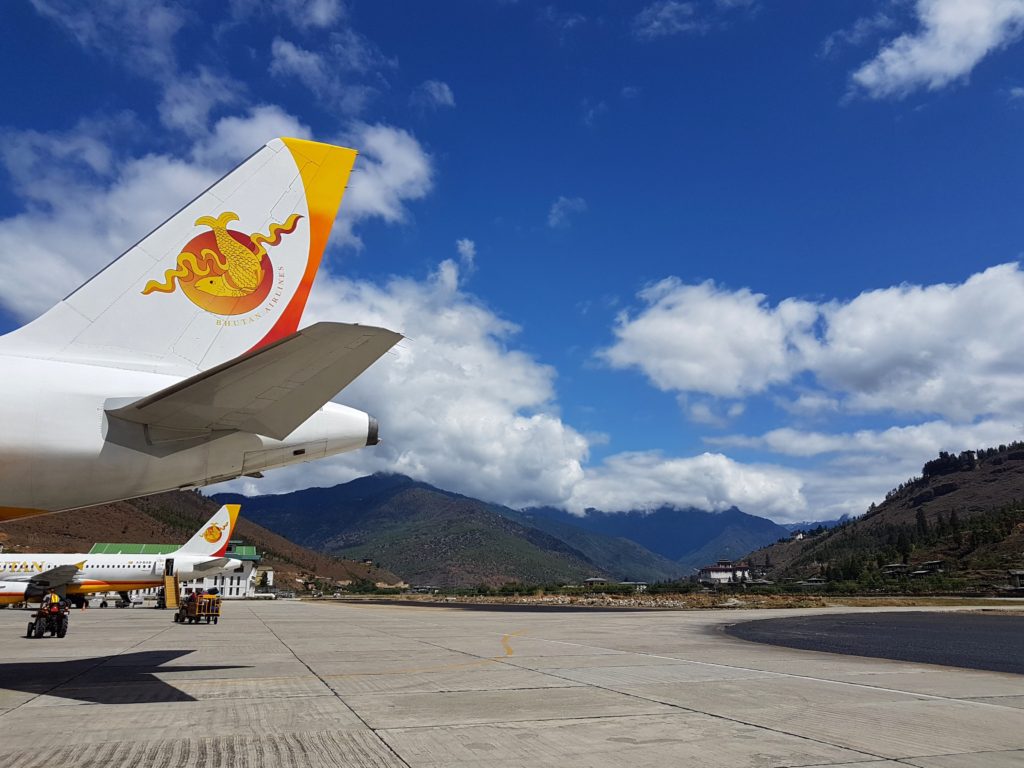
Culture and celebrations
Bhutan is one of the smallest countries in the world, but its unique cultural diversity and traditional values are highly valued. A strong emphasis is laid on protecting and preserving Bhutan’s culture and it is believed that, if preserved, it will help guard the sovereignty of the kingdom.

And that is why you would see men and women wear traditional dresses on not just special occasions but also when visiting government offices or religious places. Bhutanese men wear Gho, a knee-length robe tied by a belt, and women wear Kira, an ankle-length dress with a short jacket.

Stemming from the deep-rooted traditions, Bhutan celebrates a wide variety of elaborate and colourful religious festivals. The most important annual festival is Tshechu and every village has its own unique one that lasts for three to five days.

So, if you’d love the feeling of joy all around and the opportunity to revel to some ancient folk songs and stories weaved through mask-adorning performances, fire ceremonies and yak riding, Bhutanese festivals are quite an experience. Held in a dzong, the festival sees people from all over the village gathering together.
Spirituality – Discover your inner peace
Want to get away from your busy and chaotic life? Then there’s no other better place than Bhutan to help you achieve that sense of happiness and discover your inner peace. Travel to Bhutan to immerse yourself in the cultural, spiritual and colourful atmosphere of Bhutan.

Bhutanese culture is very much influenced by the values and principles taught by Buddhism. And Buddhism is present in every aspect of Bhutan – be it the many monasteries, dzongs, chortens, and the huge prayer wheels, the strings of colourful prayer flags and mani stones that are found all across the country.

Wildlife hotspot
Did you know that as per the constitution, 60% of land should be under forest cover at any given time! Understandably, for a country that is 71% covered with forests, it sure has a lot going for wildlife. Add to that the fact that the stringent tourist regulations also have its roots in the Bhutanese philosophy of protecting its environment.

So what awaits the wildlife lover in Bhutan? Manas, the magnificent forest that spreads across India and Bhutan, is called the Royal Manas National Park here and offers a lot in terms of wildlife sightings and just the beauty of the jungle. Elephant safaris and river rafting are big here. Red pandas can be sighted at Thrumshing La National Park, Jigme Dorji or Bumdeling. while birding is popular at Tingtibi.
Other popular options for wildlife sightings in Bhutan are the stunning Jomotsangkha Wildlife Sanctuary and the Phibsoo Wildlife Sanctuary, Phrumsengla National Park. And if you have a thing for chasing the Yeti, head for the popular Sakteng Wildlife Sanctuary in Eastern Bhutan.

If you just want a day trip involving wildlife to be woven into your itinerary, do what we did. A visit to the lovely Phobjikha valley is a great drive out of Thimphu or Punakha. The saucer-shaped valley is strikingly beautiful and, in season, the black-necked cranes are a highlight sight here, besides the wide range of fauna here.
Pristine landscape
We had mentioned it earlier…..Bhutan is covered in greenery and is the only country in the world that is carbon negative. Well, if you think this is some kind of a miracle, it’s not. The law mandates that the green cover cannot drop below 60%.

There are these pretty little towns located by the rivers with huge mountains in the backdrop and surrounded by paddy fields with colours ranging from yellow-green to dark green and all the shades in between. Then there are those curvy mountain roads winding up to high mountain passes, a different alpine scenery unfolding at each turn with the magnificent Himalayas in the backdrop.

You’d wake up every day in Bhutan surrounded by the best of nature’s beauty. So what are you waiting for?
The Dzongs
They call it a dzong – a combination of a monastery and a fortress – that you would find in every Dzongkhag (district) of the country. They are majestic and awe-inspiring and are among the most striking example of Bhutanese architecture.

You’ll find them at strategic locations – in the middle of a lush green valley, perched on a mountain ridge or by a river. The wooden entryways, the white walls, the golden yellow flared roofs and the huge courtyards with intricate detailings and brightly coloured motifs were built without the help of any drawings.
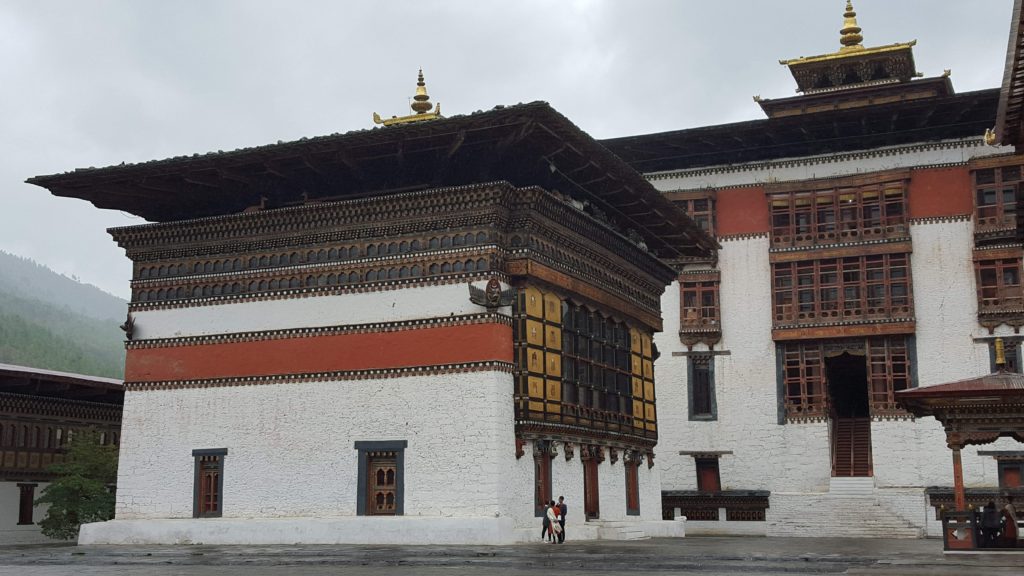
Punakha Dzong, one of the most beautiful dzongs in Bhutan, sits prettily at the confluence of the mother and father rivers, Mo Chhu and Po Chhu and is approached by a 55 m wooden cantilever bridge. Walk along the hundred-pillar assembly hall to see the wonderful murals depicting the life of Buddha.

Moreover, if you’re visiting the place during the spring months you’ll be mesmerised by the lilac-coloured jacaranda trees that stand in contrast to the dzong’s characteristically towering whitewashed walls.
Picturesque mountains and passes
Bhutan holds a lot of its natural beauty in the Himalayan peaks, vibrantly rich forests, frothy rivers and valleys. Two valleys are accessible only through high passes.

The highest pass in Bhutan is Chelela Pass located at an altitude of 13,08 4ft. Hold onto yourself, coz if the rustic beauty of the mountain pass, the fluttering prayer flags and the lush green Haa valley stretching down below does not get you, the strong winds will.

Dochula Pass, on the way between Thimphu and Punakha, is where you will find 108 memorial chortens and the breath-taking 360 degrees panoramic of the surrounding snow-clad Himalayan ranges and verdant slopes.
A trekker’s paradise
How excited are you to cross wind-whipped mountain passes, skirt along alpine lakes, walk through ancient pine and oak forests, spotting an occasional sacred chorten in the wilderness, and passing through some of the least-visited valleys laden with wildflowers like primulas and blue poppies, encountering herdsmen and their yak!!!

Sounds enticing, doesn’t it? You’d have some of the highest unclimbed mountains in the world, including Mt. Jitchu Drake, Mt. Gangkar Puensum and Mt Jhomolhari, looming over you and protecting you.

Mountains are forbidden to climb as a means not to upset the deities and spirits that live there. However, trekking is allowed.
The Druk Path trek that links Thimphu and Paro reaches a maximum altitude of about 13500 feet. This moderate trail covers a distance of 50 km in 4-5 days passing several lakes, high mountain passes and forests with excellent views of Mt. Gangkar Puensum.

Snowman trek is a popular trek in Bhutan but is also one of the hardest routes in the world. The trek takes around 25 days and traverses 11 passes and through the remote mountainous regions between Bhutan and Tibet. If you are a fit and experienced trekker, go for it!
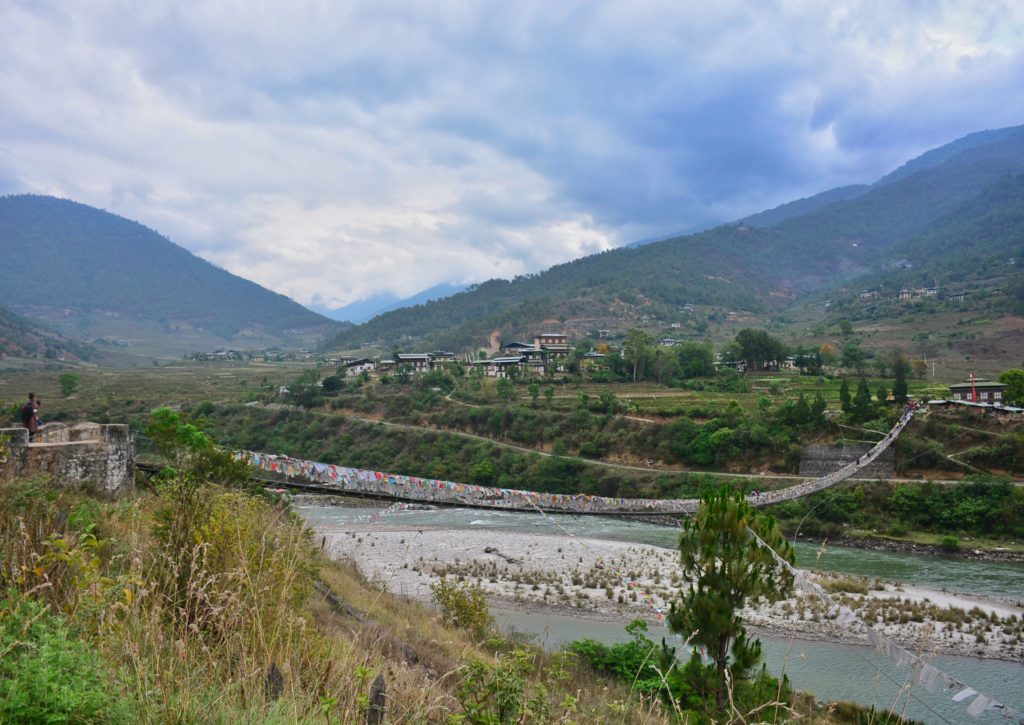
If you are a beginner, the three-day Owl Trek is a good option. The trail follows the hills around Bumthang, passing through forests and a few authentic Bhutanese villages inhabited by the indigenous nomadic communities.
The Tiger beckons!
Okay, so everyone who has looked up Bhutan as a travel destination knows the legendary Tiger’s Nest Monastery or Taktsang Goemba. It is the most recognisable images that represent Bhutan. This sacred monastery perched on the side of a rocky vertical cliff at 3000m is reason enough to travel to Bhutan.

Bhutanese believe that Guru Padmasambhava flew to this cliff on a flying tigress in order to subdue a demon residing here and meditated in a cave. You can reach the monastery via a short two-hour trek. The trek takes you through some beautiful rhododendron, pine and oak forests, moderately steep slopes, descending and ascending stone steps, giant prayer wheels, colourful payer flags, wooden bridges and extremely beautiful vantage points.

From the monastery it’s also possible to take in the best view of the hike, no photos are allowed inside the monastery though. The flickering traditional butter lamps cast a warm ethereal light on the sitting bronze Padmasambhava idol. The idol was unscathed after a fire destroyed many of the buildings in 1998.
Easy going cities and towns
Bhutan’s capital, Thimphu, is different from all the other bustling metropolitan cities around the world. The largest city has both an old-world charm and modernity to it. The giant Buddha Dordenma statue at Thimphu is one of the largest statues of Buddha and made of bronze and gilded in gold.

Paro receives the maximum number of tourists year-round for good reasons. There is the attractive Paro dzong, the iconic Tiger’s Nest Monastery, Bhutan’s only international airport, and some quaint shopping streets.

Another breathtaking travel destination in Bhutan is Punakha. The famous 17th-century fortress Punakha Dzong which sits majestically at the confluence of the Pho and Mo Chhu.
Unique delectable cuisines
When in Bhutan, say cheese. Not just because it is one of the happiest countries on earth. Nor because there is a photo op just about everywhere. But because cheese is really big in Bhutanese cuisine. Which is why you will find datshi in almost every dish you have here and, trust us, it really is quite a treat. Ema Datshi is the national dish of Bhutan and its made of spicy chillies and cheese.
Adding to the other-worldliness of the trip, another aspect that will ‘bowl’ you over is the Bhutanese cuisine. It’s is food that both comforts you with its simple yet wholesome dishes.

But it can also unsettle you, in a good way mostly, but those who can’t handle chilli peppers would need to watch what you are eating. You will find them in almost every preparation. And it is a great combination with the wide variety of meats and vegetables they use.
Lovely people
The Bhutanese are genuinely the most friendly and down to earth people you will meet anywhere. It’s not just their welcoming nature and their smiling faces. Since they are rich with strong Buddhist values, they believe in being kind to others.

Of course, when it comes to making you feel at home, Bhutan and the Bhutanese are particularly good. So, it can be the best of both worlds. You feel at home too and yet take in the mysteries and the unexpected in a pleasant and novel environment. We had many interactions during our 10 days in Bhutan, but never did we feel insecure or even as strangers.
Safe to travel in Bhutan
We all need to be safe when we travel, don’t we?
It is safe….that’s one of the reasons why you should travel to Bhutan! There is something quite lulling and laidback about this east Himalayan kingdom. Moreover, with one of the friendliest people and among the lowest crime rates in the world, Bhutan is one of the safest.
If you have travelled anywhere at all in the Himalayas, you will feel at home in Bhutan. If you are familiar with the Himalayas, you will immediately connect with Bhutan. So, whether you’re planning your honeymoon, a family holiday or travelling with your friends, Bhutan definitely ticks all the right reasons and boxes.
Regulated and responsible tourism policy
Bhutan opened its doors to international tourists in 1974. However, the one reason why you do not see a surge of tourists backpacking and travelling in Bhutan like neighbouring India and Nepal is its high value, low impact tourism policy.

There is a minimum fee of $250 and $200 per person per day in the high and low season, respectively. This is appliable for tourists from all over the world, except India, Bangladesh, and the Maldives. This amount might seem expensive but it covers accommodation, transport within Bhutan, a driver, licensed tourist guide, food and non-alcoholic drinks, and entry fee. Moreover, 30% of the fee, i.e. around $65 of the money is sustainable development fee (SDF) that goes directly to the government to support social welfare programmes.

Tourists from India, Bangladesh and the Maldives were exempt from a levy that other nationals have to pay. However, from February 2020, tourists from India, Bangladesh and the Maldives have to pay an SDF of 1,200 ngultrums (Rs 1,200.17) per day.

This limits the number of tourists entering the country, helping to preserve the landscape and traditional culture. In Bhutan, it works as an advantage especially for those who prefer a package tour, a fully guided experience and the highest quality travel experiences.
Definitely another reason to travel to Bhutan, right?

With so many reasons to travel, Bhutan is one of the most fascinating countries to visit. Who wouldn’t want to travel to Bhutan, the land of happiness, culture, natural beauty and peace? So, when are you planning yours?




